
Franklin County is a county along the Gulf of Mexico in the panhandle of the U.S. state of Florida. As of the 2020 census, the population was 12,451, making it the third-least populous county in Florida. The county seat is Apalachicola.

Martin County is a county located in the southeastern part of the state of Florida, in the United States. As of the 2020 census, the population was 158,431. Its county seat is Stuart. Martin County is in the Port St. Lucie, FL Metropolitan Statistical Area.

Howey-In-The-Hills is a town in Lake County, Florida, United States. The population was 1,643 at the 2020 census. It is part of the Orlando–Kissimmee–Sanford Metropolitan Statistical Area.

Biscayne Park is a village in Miami-Dade County, Florida, United States. It's also part of the Miami metropolitan area of South Florida. As of the 2020 census, the population was at 3,117 residents.

Country Club is a census-designated place and a suburban unincorporated community located in northwest Miami-Dade County, Florida, United States. It is located in the Miami metropolitan area of South Florida. The CDP is named after the Country Club of Miami, which was established in 1961 in what was then an unpopulated and undeveloped section of the county. The population was 49,967 at the 2020 census, up from 3,408 in 1990.

Miami Lakes is an incorporated town in Miami-Dade County, Florida, United States. The town is part of the Miami metropolitan area of South Florida. As of the 2020 census, the population was 30,467.

Palm Springs North is an unincorporated community and census-designated place (CDP) in Miami-Dade County, Florida, United States. It is part of the Miami metropolitan area of South Florida. The population was 5,030 at the 2020 census.

Westwood Lakes is a census-designated place and unincorporated community of Miami-Dade County, Florida, United States. It is part of the Miami metropolitan area of South Florida. The population was 11,373 at the 2020 census.
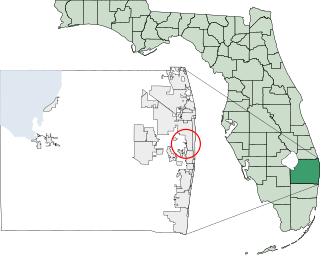
Cloud Lake is a town in Palm Beach County, Florida, United States. It is part of the Miami metropolitan area of South Florida. As of the 2020 US census, the town had a population of 134 residents.
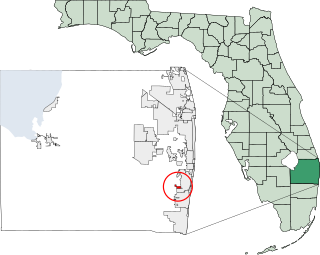
The Village of Golf is a village in Palm Beach County, Florida, United States. It's also part of the Miami metropolitan area of South Florida. As of 2020, the population recorded by the U.S. Census Bureau was 255.

Greenacres is a city in Palm Beach County, Florida, United States. It is part of South Florida's Miami metropolitan area. As of the 2020 census, the city had a population of 43,990 residents.

Haverhill is a town in Palm Beach County, Florida, United States. It is a part of the Miami metropolitan area of South Florida. Haverhill became a town on May 3, 1950, and was named after the city of Haverhill, Massachusetts. The town is located in east-central Palm Beach County near the western periphery of the Palm Beach International Airport, and is also small geographically, encompassing just 0.63 square miles (1.6 km2). The population of the town was 2,187 as of the 2020 US Census.
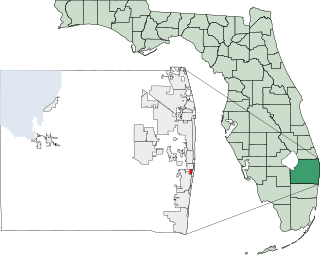
Hypoluxo is a town in Palm Beach County, Florida, United States. The town was incorporated in 1955 and is part of the Miami metropolitan area of South Florida. It is home to the Hypoluxo Scrub Natural Area, which is a protected landscape. The population was 2,687 at the 2020 US Census.
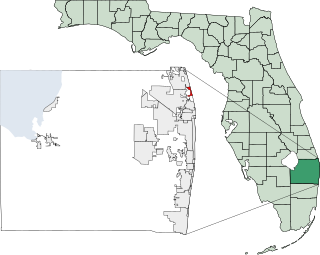
Juno Beach is a town in Palm Beach County, Florida, United States. Juno Beach is home to the headquarters of Florida Power & Light, the Loggerhead Marinelife Center and the Seminole Golf Club. It was also the original county seat for the area that was then known as Dade County. Juno Beach is in the Miami metropolitan area. The political climate in Juno Beach is leaning liberal. The property crime rate is around the US national average, with the violent crime rate well below average. The Town of Juno Beach was officially incorporated in 1953. As of 2020, the town's population recorded by the U.S. Census Bureau was 3,858.

Manalapan is a town in Palm Beach County, Florida, United States. It is part of the Miami metropolitan area of South Florida. The population was 419 at the 2020 United States census.

North Palm Beach is an incorporated village in Palm Beach County, Florida, United States. It is part of the Miami metropolitan area of South Florida. The village won an award from the National Association of Home Builders as best planned community of 1956. The North Palm Beach Country Club is home to a Jack Nicklaus Signature golf course. The population was 13,162 at the 2020 US census.

Palm Beach Shores is a town in Palm Beach County, Florida, United States. The town is part of the Miami metropolitan area of South Florida. The population was 1,330 at the 2020 US census.
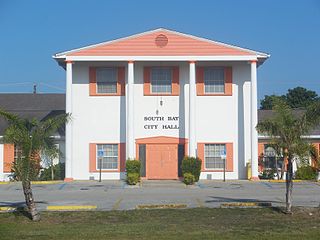
South Bay is a city in Palm Beach County, Florida, United States. It is the westernmost municipality in the South Florida metropolitan area. As of 2020, the population recorded by the U.S. Census Bureau was 4,860 residents. While the current estimates place South Bay's population in the incorporated city limits at more than 4,000 people, surrounding areas increase the population figures to 54,000 people in a 25-mile (40 km) radius and more than 1.4 million in a 50-mile (80 km) radius.
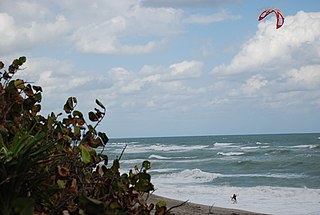
Tequesta is an incorporated village in Palm Beach County, Florida, United States. It is the northernmost municipality in the Miami metropolitan area, which according to the 2020 United States Census, had a total population of 6,138,333 South Florida residents. As of 2020, the US Census had the village's total at 6,158 of the population.

Haines City is a city in Polk County, Florida, United States. Its population was 13,174 at the 2000 census and 20,535 at the 2010 census. It is the third most populous city in Polk County. It is part of the Lakeland–Winter Haven Metropolitan Statistical Area.





















